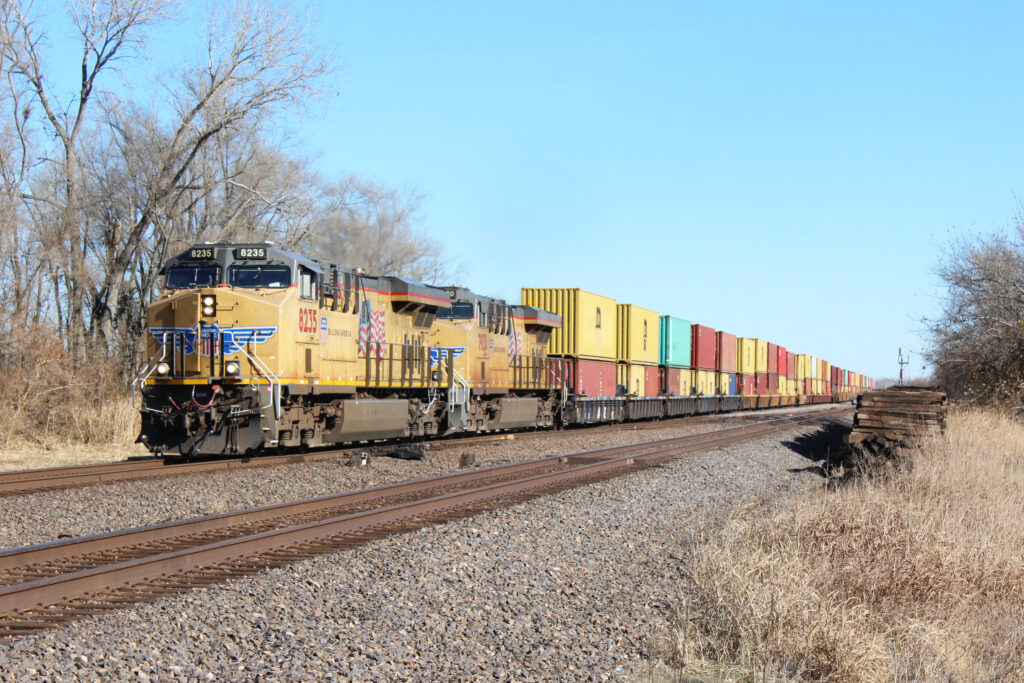All about the community of model railroading and rail enthusiasm
November 1, 2021 / Updated June 26, 2023
OMAHA, NE — Union Pacific Railroad is taking additional steps to reduce global supply chain congestion with a weekend incentive to help relieve intermodal shipment backlogs. By offering refunds on some containers, the railroad hopes to speed goods and products moving across the United States from West Coast ports.
The move comes as railroads experience continued intermodal shipment backlogs, which is contributing to a decline in North American rail traffic. The Association of American Railroads, which charts weekly traffic, reports steady dips in North American carload and intermodal shipments since the end of July.
In the U.S., intermodal shipments have been down an average of 8 percent since the week ending Sept. 18.

To encourage weekend in-gates and reduce port backlog, UP will run a pilot program through Dec. 31 offering a $60 per container refund to its ocean carrier customers for each container in-gated Saturdays and Sundays at its near-port Intermodal Container Transfer Facility (ICTF) in Long Beach, CA. The refund will apply to containers in-gated incremental to each customer’s current 2021 weekend average.
Union Pacific recently increased gate access to around the clock at ICTF, adding 20 weekend hours, providing customers more opportunities to get freight in and out. The move supports Port of Los Angeles and Port of Long Beach recent shifts to 24/7 operations.
The refund reflects a UP effort to work proactively with key transportation stakeholders and its customers to ease supply chain congestion. The Class I railroad has reopened its Global III terminal outside Chicago and its Englewood terminal in Houston to provide additional inland storage. Freight also has been shuttled to less stressed terminals in the same geographic area to maximize availability for customers.
With the nationwide driver shortage contributing to congestion, UP’s UPGo app is decreasing the time it takes a driver to drop off and pick up intermodal containers, and subsidiary drayage capacity is being utlitized through its LOUP subsidiary to help shippers.
“It’s critical we get drivers back on the road, and the app allows them to complete critical tasks, such as pre-registering their box and getting real-time parking information before they arrive,” said Kari Kirchhoefer, VP premium, marketing and sales. “We’re also doing things like creating uniform signage at all of our facilities, so it’s easier to find what they need and get help, if necessary.”
Railroads enjoyed surges in shipping for the first half of 2021, but supply chain issues are chipping away at gains. Overall, U.S. and North American carloads and intermodal units are up compared to 2020, according to AAR.
Combined North American rail traffic in the U.S., Canada and Mexico improved 6.9 percent through the first 42 weeks of 2021 compared to 2020.
U.S. carload and intermodal shipments are leading the growth with cumulative volume of 9,718,385 carloads (up 7.5 percent) and 11,617,749 intermodal units (up 8.5 percent). Total combined U.S. traffic through Oct. 23 was up 8 percent compared to last year.
Canadian railroads reported cumulative rail traffic volume of 6,228,236 carloads, containers and trailers, up 4.1 percent. Cumulative volume on Mexican railroads for the first 42 weeks was 1,516,351 carloads and intermodal containers and trailers, up 3.6 percent from the same point last year.
Lately, however, carloads and intermodal units have dipped across the continent. In addition to fewer intermodal shipments, motor vehicles and parts have declined significantly, due mostly to the micro-chip supply shortage. Since July 4, weekly North American automotive shipments are down, as much as 34 percent for the week ending Sept. 18.